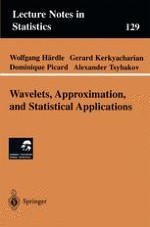The mathematical theory of ondelettes (wavelets) was developed by Yves Meyer and many collaborators about 10 years ago. It was designed for ap proximation of possibly irregular functions and surfaces and was successfully applied in data compression, turbulence analysis, image and signal process ing. Five years ago wavelet theory progressively appeared to be a power ful framework for nonparametric statistical problems. Efficient computa tional implementations are beginning to surface in this second lustrum of the nineties. This book brings together these three main streams of wavelet theory. It presents the theory, discusses approximations and gives a variety of statistical applications. It is the aim of this text to introduce the novice in this field into the various aspects of wavelets. Wavelets require a highly interactive computing interface. We present therefore all applications with software code from an interactive statistical computing environment. Readers interested in theory and construction of wavelets will find here in a condensed form results that are somewhat scattered around in the research literature. A practioner will be able to use wavelets via the available software code. We hope therefore to address both theory and practice with this book and thus help to construct bridges between the different groups of scientists. This te. xt grew out of a French-German cooperation (Seminaire Paris Berlin, Seminar Berlin-Paris). This seminar brings together theoretical and applied statisticians from Berlin and Paris. This work originates in the first of these seminars organized in Garchy, Burgundy in 1994.
